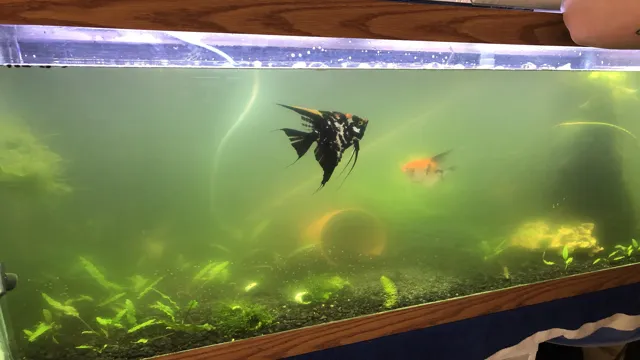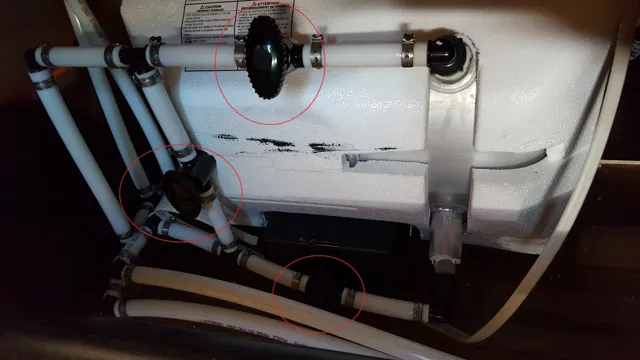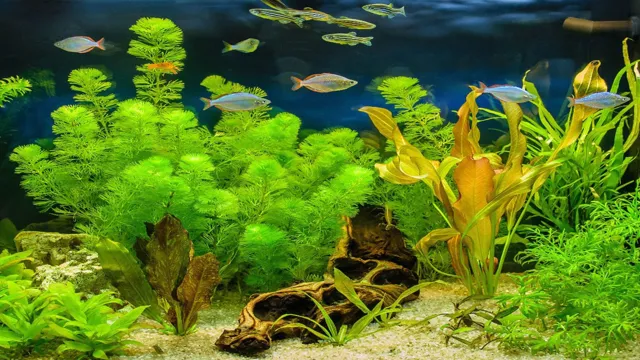As an aquarium enthusiast, you know that having a healthy bacterial colony in your tank is essential for the well-being of your aquatic pets. But how do you get those natural bacteria to thrive in your aquarium? Well, fear not, because we have some tips that are sure to help you out. Firstly, one of the most effective ways to promote the growth of natural bacteria in your aquarium is by maintaining good water quality.
This means keeping an eye on the pH levels, ammonia, nitrate, and nitrite levels, and making sure they’re within the appropriate range for your fish and other aquatic animals. Secondly, you can add live plants to your aquarium. Live plants are known to be excellent natural filters for aquariums, providing a habitat for beneficial bacteria that help break down waste products like fish excrement, uneaten food, and decaying matter.
Thirdly, choose substrates like sand, gravel, or absorbent media, which act as efficient biological filters by providing surface areas for bacteria to colonize. Lastly, consider using natural bacteria supplements to help your aquarium cycle quickly and efficiently. These supplements contain strains of beneficial bacteria that can help stabilize your aquarium, reduce ammonia and nitrite levels, and prevent common aquarium problems.
In conclusion, getting natural bacteria to thrive in your aquarium requires a combination of good water quality, live plants, efficient substrates, and natural bacteria supplements. By following these tips, you’ll be well on your way to maintaining a healthy, thriving aquarium that your aquatic pets will love.
Understanding Aquarium Bacteria
If you’re wondering how to get natural bacteria in aquariums, the answer lies in establishing a healthy ecosystem for your fish. Aquarium bacteria play a crucial role in maintaining water quality and preventing harmful ammonia and nitrate buildup. One way to kickstart natural bacterial growth is by adding live plants to your tank.
Plants provide a food source for bacteria while absorbing harmful substances like carbon dioxide and nitrates. Another method is by cycling your aquarium before adding fish. This process involves allowing beneficial bacteria to grow and establish in the tank’s gravel and filter media.
Using a starter bacteria product or adding water from an established tank can also introduce natural bacteria to the aquarium. By providing a habitat for beneficial bacteria, you’ll ensure the long-term health and well-being of your aquatic pets.
The Importance of Natural Bacteria
Aquarium bacteria are essential for the proper functioning of an aquatic ecosystem. Natural bacteria serve as a biological filter to remove harmful chemicals and waste produced by fish and plants. They also help to break down organic matter, such as uneaten food and dead plant material, preventing the buildup of toxic substances.
It is important to understand the role of bacteria in maintaining a healthy aquarium as they play a vital part in keeping the water clean and safe for aquatic life. Without these tiny microorganisms, the ecosystem can quickly become imbalanced, leading to poor water quality, declining fish health, and potential disaster. Therefore, it is crucial to provide adequate conditions for the growth of beneficial bacteria in the aquarium, such as a consistent temperature, ample oxygenation, and a suitable substrate.
Regular water testing is also recommended to monitor the levels of essential bacteria and ensure the aquarium stays healthy for all its inhabitants. Remember, just as we rely on our gut microbiome, aquatic life relies on the natural bacteria in their environment to thrive.

Types of Natural Aquarium Bacteria
Aquarium bacteria are crucial in maintaining a healthy aquatic environment. These beneficial microorganisms play a significant role in breaking down organic waste and converting harmful compounds into less toxic substances. Understanding the types of natural aquarium bacteria can help us create a more stable and sustainable ecosystem for our aquatic pets.
There are three major categories of aquarium bacteria: nitrifying bacteria, denitrifying bacteria, and beneficial bacteria. Nitrifying bacteria are responsible for converting ammonia and nitrite to nitrate, while denitrifying bacteria convert nitrate to nitrogen gas. Beneficial bacteria work to break down organic matter and remove toxins from the water. (See Also: How to Attach Background to Aquarium: A Step-by-Step Guide for a Stunning Underwater View)
Each category of bacteria has specific functions and requirements for optimal growth and survival. By maintaining a healthy balance of these microorganisms, aquarium owners can ensure the longevity and well-being of their aquatic pets.
Methods to Introduce Natural Bacteria in Aquariums
If you’re setting up a new aquarium or trying to maintain a healthy environment for your fish, introducing natural bacteria is essential. These bacteria help break down waste products and maintain optimal water quality for your aquatic pets. One way to introduce natural bacteria is by using live plants.
Plants naturally contain bacteria that can help establish a healthy ecosystem in your aquarium. Another option is to use a bacterial supplement or additive. These products contain natural bacteria cultures that can help jumpstart the bacteria population in your tank.
Additionally, using a quality aquarium filter can also contribute to the growth of natural bacteria. As water passes through the filter media, bacteria naturally colonize it, breaking down waste products and improving water quality. By utilizing these methods, you can ensure your aquarium has a healthy population of natural bacteria to help keep your fish happy and healthy.
Adding Live Plants and Substrates
If you’re looking to add live plants and substrates to your aquarium, it’s important to consider how you’ll introduce natural bacteria into the tank. This is because live plants and substrates can harbor beneficial bacteria that help to break down waste and ensure a healthy environment for your fish. One way to introduce natural bacteria is by adding beneficial bacteria supplements to the water.
These supplements contain live strains of beneficial bacteria that can help to kickstart the nitrogen cycle and establish a healthy balance in your tank. Another method is to add a handful of gravel or plant material from an established tank. This can transfer beneficial bacteria to your tank and help to establish a healthy ecosystem.
Additionally, you can simply allow your tank to cycle naturally over a period of weeks or months. This can take longer, but it’s a natural and sustainable way to establish a healthy ecosystem in your aquarium. Regardless of the method you choose, introducing natural bacteria is essential when adding live plants and substrates to your aquarium.
It can help to ensure a healthy environment for your fish and make your aquarium a thriving ecosystem.
Cycling the Aquarium
If you’re a seasoned aquarist, you probably know that cycling your aquarium is vital to establishing the proper balance in your tank. But did you know that adding natural bacteria can help speed up the process? There are a few methods for introducing these beneficial bacteria, including using live sand or rock, adding bacterial supplements, or even simply allowing your filter media to mature before adding fish. These bacteria play a crucial role in breaking down harmful ammonia and nitrite, ensuring that your fish have a safe and healthy environment to thrive in.
So if you want a thriving aquarium, don’t forget to consider the benefits of natural bacteria in your tank.
Using Natural Bacteria Supplements
Natural Bacteria Supplements Introducing natural bacteria in aquariums is an important part of maintaining a healthy aquatic environment. There are a few ways to do this, starting with introducing live plants that can help absorb excess waste and provide a natural habitat for beneficial bacteria to grow. Another way is by adding organic materials, such as leaves or wood, which can also provide a suitable environment for bacteria to thrive. (See Also: How to Clean Sponge Filter in Aquarium: A Step-by-Step Guide for Sparkling Water)
However, the most effective method is by using natural bacteria supplements. These supplements contain live bacteria that help break down waste and convert harmful toxins into harmless substances. They come in different forms, such as liquid or powder, and are easy to use.
Simply add the recommended dosage to your aquarium and let the bacteria work their magic. With regular use, natural bacteria supplements can help maintain a healthy and balanced ecosystem in your aquarium.
Maintaining Natural Bacteria in Aquariums
Maintaining natural bacteria in aquariums is crucial for the overall health and well-being of the aquatic environment. One way to introduce beneficial bacteria into your aquarium is by using live plants. Plants provide a surface area for bacterial colonization and can help regulate nitrogen cycles.
Another method is to allow the aquarium to cycle naturally. This process can take several weeks to months but allows the necessary nitrifying bacteria to establish and thrive. It’s important to avoid excessive cleaning or changing of the aquarium water, as this can disrupt the natural balance of bacteria.
Adding a bacterial supplement can also aid in establishing a healthy microbial community. By ensuring the presence of natural bacteria in your aquarium, you can provide a safe and sustainable habitat for your aquatic pets.
Avoid Overfeeding and Overstocking
Maintaining natural bacteria in aquariums is crucial to ensure a healthy environment for your fish. Overfeeding and overstocking can disrupt the balance of bacteria in the water, leading to a buildup of harmful toxins that can harm your aquatic pets. To avoid this, it’s important to only feed your fish the amount they need and avoid overfeeding.
Additionally, make sure you don’t overcrowd your aquarium with too many fish or decorations, as this can lead to a lack of oxygen in the water and increase the risk of disease. Maintaining a consistent temperature and pH level in the water can also help keep the bacteria in check. Regular water changes and cleaning of the aquarium can help remove any excess waste and maintain a healthy balance of natural bacteria.
By following these tips, you can create a thriving aquatic environment for your fish to enjoy.
Regular Water Changes
One of the most crucial aspects of maintaining a healthy aquarium is performing regular water changes. Not only does this help to remove excess debris and waste, but it also helps to maintain the natural bacteria that inhabit the tank. These bacteria play a vital role in the aquarium ecosystem, breaking down harmful compounds such as ammonia and nitrite into less toxic compounds.
Over time, these bacteria can become depleted or overwhelmed, leading to imbalances in the tank and potential health issues for the fish and other aquatic creatures. By performing regular water changes, we can help to keep these bacteria thriving and ensure a healthy environment for our aquatic pets. So, don’t forget to incorporate this essential maintenance task into your aquarium care routine to support the natural balance of your tank!
Conclusion
To get natural bacteria in your aquarium, all you need is patience, a little bit of magic from Mother Nature, and some fish poop, of course. Remember that a healthy ecosystem takes time to establish, and that trying to rush the process can lead to disaster. So sit back, relax, and let nature do its thing. (See Also: How to Make a Wooden Aquarium: A Simple Guide for DIY Enthusiasts)
Who knows, you might even learn a thing or two about balance and harmony in the process.”
FAQs
What is natural bacteria in aquariums?
Natural bacteria in aquariums are beneficial microorganisms that help break down harmful waste products produced by fish and other aquatic organisms.
How do I get natural bacteria in my aquarium?
There are several ways to introduce natural bacteria into your aquarium, including using live sand or rock, adding a bacterial supplement, or allowing the tank to cycle naturally over time.
Why is natural bacteria important for a healthy aquarium?
Natural bacteria play a crucial role in maintaining a stable and healthy aquarium environment. They break down toxic waste products, reduce the risk of disease, and promote overall water quality.
Can using chemical treatments harm natural bacteria in my aquarium?
Yes, some chemical treatments can harm or even kill natural bacteria in your aquarium. It’s important to carefully research and read the labels of any chemical products you plan to use, and avoid those that could harm beneficial microorganisms.
How can I tell if my aquarium has enough natural bacteria?
You can test the levels of natural bacteria in your aquarium by using a bacteria test kit. If the levels are low, you can try adding a bacterial supplement or increasing the amount of live sand or rock in the tank.
What are some signs that my aquarium may have a bacterial imbalance?
Symptoms of a bacterial imbalance in an aquarium can include cloudy or discolored water, foul odors, sluggish or sickly fish, and excessive algae growth.
How often should I add a bacterial supplement to my aquarium?
The frequency of adding a bacterial supplement depends on the specific product you are using and the size of your aquarium. It’s important to follow the manufacturer’s recommendations and monitor the levels of natural bacteria in your tank regularly.







